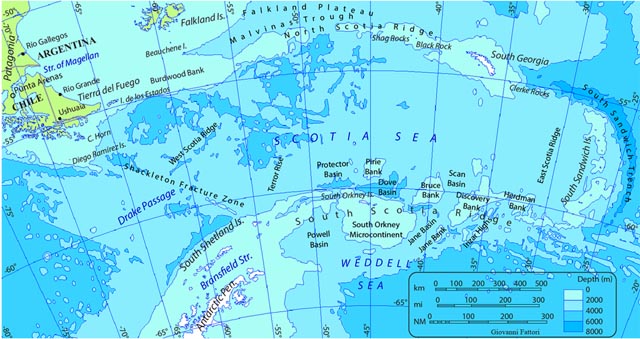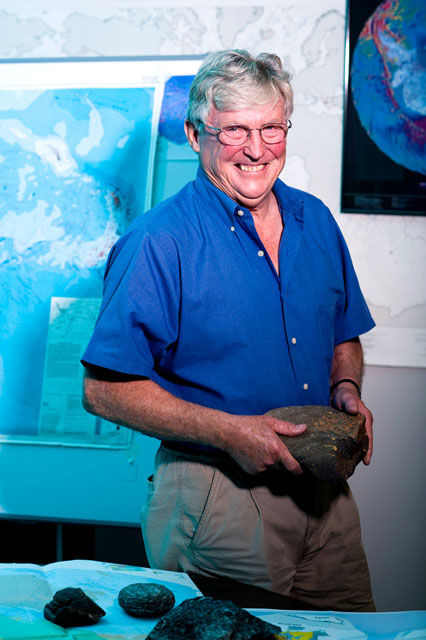Shutting the doorGateway hypothesis for Antarctic glaciation takes another knock from new studyPosted September 5, 2014
Is the door slowly shutting on a four-decade-old theory of how Antarctica got its ice on? A new paper in the prestigious journal Nature suggests that 34 million years ago, as the world transitioned out of a warm greenhouse climate into a climate that more closely resembles modern conditions, decreasing levels of carbon dioxide (CO2) in the atmosphere initiated the glaciation of Antarctica. Scientists used a numerical climate model to show that the presence of an Antarctic ice sheet nearly the size of the present-day one during the Eocene-Oligocene transition helps explain previous evidence of cooling and changes in ocean circulation. In other words, the ice sheet, rather than being a passive player in the climate system, plays an active role in influencing conditions, particularly in the surrounding oceans. It’s the latest research to suggest that the main competing theory for the growth of major ice sheets – formation of a huge, circular ocean current around Antarctica as ocean gateways between continents opened – is becoming unhinged. 
Photo Credit: Wikipedia Commons
The Drake Passage and Scotia Sea, one of the last gateways to open up that allowed the Antarctic Circumpolar Current to flow. The timing and significance of that event in the history of Antarctic glaciation continues to be hotly debated.
The ocean gateway hypothesis, proposed in the 1970s by James Kennett This belt of cold water spins around Antarctica from west to east ,driven by Earth’s rotation and the westerly wind system, effectively insulating the continent from the intrusion of warmer ocean water. The theory then goes that the deep ocean current would have isolated Antarctica — its massive ice sheets began to grow at around that time — and helped tip the world into a cooler period. The paper by Aaron Goldner Instead, the Nature paper bolsters the theory that the ice sheet on Antarctica grew as levels of CO2 in the atmosphere declined. The climate model used by the team showed that changes in ocean temperature gleaned from sediment cores extracted from the deep seafloor could be explained better by the influence of an ice sheet rather than the ACC. “I think it’s extremely interesting. It turns things on its their ear a little bit in terms of it being the ice causing a lot of these changes and not the circumpolar current,” said Ian Dalziel A geologist not involved with the Goldner et al study, Dalziel has been investigating the ocean gateway hypothesis for decades. Some of his latest research, published last year in the journal Geology, has also put a dent into the 40-year-old theory. In the Geology paper, Dalziel and colleagues analyzed rocks dredged from an area of the Southern Ocean known as the central Scotia Sea during a research cruise in 2008 supported by the National Science Foundation’s Division of Polar Programs The underwater topography from such a rise in the seafloor would have impeded the formation of a deep ocean current, implying that the ACC didn’t initiate Antarctic glaciation. Dalziel and his team are scheduled to return to the Scotia Sea in September 2014 to collect more samples. In addition, they’ll install several high-precision GPS units on South Georgia Island in the region to determine if the current tectonic movement matches the emerging theory about the volcanic arc. What caused the decline in carbon dioxide concentrations more than 30 million years ago is itself still a subject of debate. One enduring theory involves the uplift of the Tibetan Plateau near the end of the Eocene. Some scientists have suggested that the Tibetan Plateau, about a third the size of the United States, changed atmospheric circulation and wind patterns. It also created the regional monsoons that bring heavy rain. These heavy rains then help remove large amounts of carbon dioxide from the atmosphere. The carbon dioxide in the rain reacted with silicate rock that was exposed as the plateau continued to rise. The rain weathered the rock, and the minerals found their way into the ocean, where sea animals used them to form their shells. The minerals were eventually deposited as limestone on the ocean floor, as part of a process called chemical weathering. In response to an e-mail about the implications of the paper, Goldner, currently working in Washington, D.C., as the AGU/AAAS Congressional Science Fellow in the office of Senator Sheldon Whitehouse, said that the ocean gateway hypothesis isn’t completely gone. “Any reorganization of continents could have contributed to drawdown of CO2 by creating areas of upwelling and nutrient-rich water,” he said, adding that previous research suggested that even a gradual reduction in atmospheric carbon dioxide alone is enough to account for the formation of the Antarctic ice sheet without any additional contributing factors. An ice sheet about three-quarters the size of the one that blankets Antarctica today – containing 90 percent of the world’s ice and 70 percent of its freshwater – would have taken about 30,000 to 35,000 years to grow at the time of the Eocene-Oligocene boundary, based on estimates from one of Goldner’s collaborators, Edward Gasson “Our simulations are unique because we have a fully interactive ocean which takes 3,000-plus years of model years and [two] straight years of running the simulations on super computers,” he explained. “A modeling simulation that includes fully interactive ocean, land, sea-ice, land-ice, and atmosphere still is not operational for paleoclimate modeling in the United States, but is close.” Co-author Matthew Huber “It should be clear that resolving these two very different conceptual models for what caused this huge transformation of the Earth’s surface is really important because today as a global society we are, as I refer to it, dialing up the big red knob of carbon dioxide but we’re not moving continents around,” he said in a statement. NSF-funded research in this article: Matthew Huber and Gabriel Bowen, Purdue University, Award No. 0902882 |



For USAP Participants |
For The Public |
For Researchers and EducatorsContact UsU.S. National Science FoundationOffice of Polar Programs Geosciences Directorate 2415 Eisenhower Avenue, Suite W7100 Alexandria, VA 22314 Sign up for the NSF Office of Polar Programs newsletter and events. Feedback Form |


